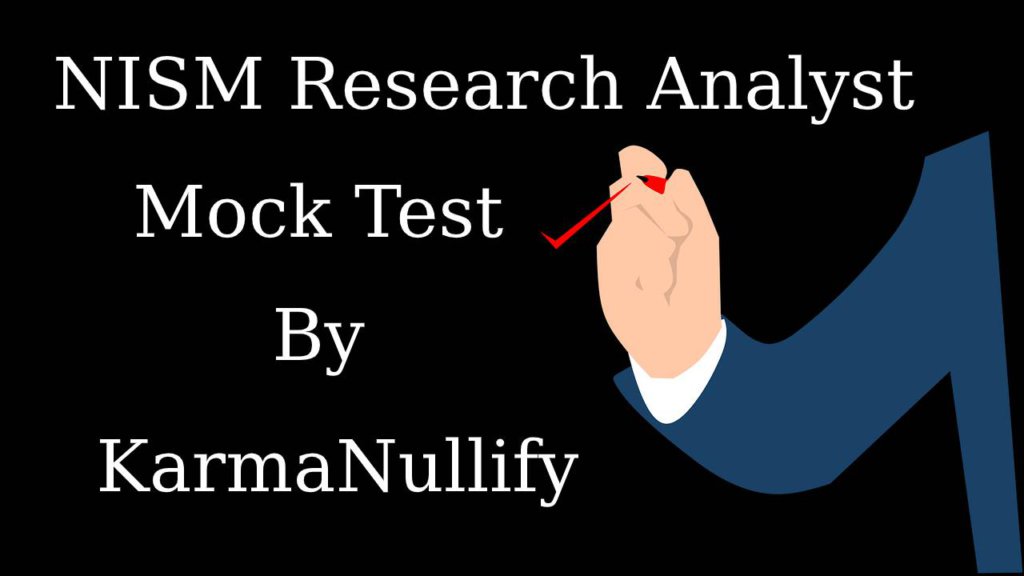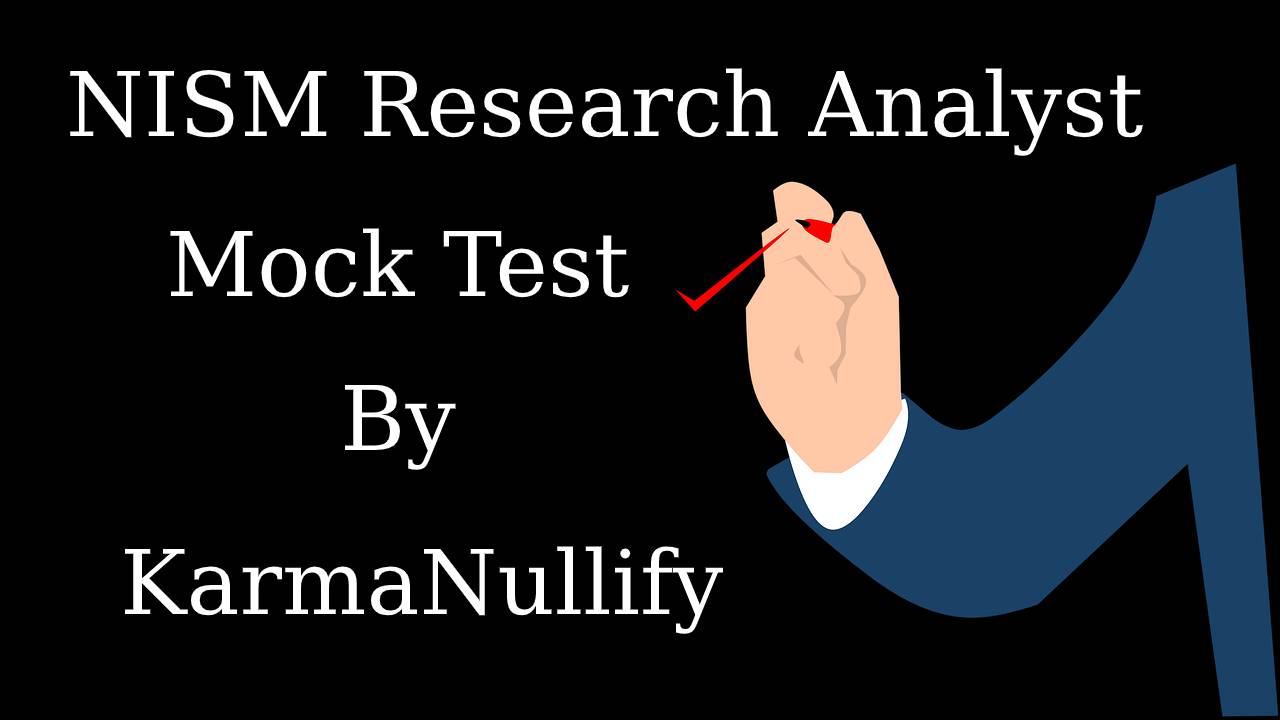Who Should Prepare NISM Research Analyst Certification Examination?
As per SEBI (Research Analysts) Regulations, an associated person should be required to qualify the NISM Series-XV: Research Analyst Certification Examination.
So, It is very crucial examination for associated person in the financial service industry that includes all Research analyst working in all Broking and Advisory firm in India.
This NISM exam basically test the capability of the candidate whether they have sufficient knowledge to become a Research Analyst.
As this NISM Research Analyst Examination, covers all the crucial topics which are necessary for the analysis of any company for Stock investment. Therefore, an Finance enthusiast can also appear for this exam.
This will help them to get basic knowledge on Indian Securities Market. Your knowledge on qualitative and quantitative company analysis will also enhances as their is a separate unit for this topic alone.
Study Material For NISM XV:
You can buy Nism XV workbook from store or you can get previous edition of Ebook of NISM XV from here free of cost.
We have also created NISM Mock test which will help you to get good score. This mock test covers all 13 Chapters of NISM XV completely with detailed explanation of every questions along with all problem solving Numericals of NISM XV syllabus.
NISM Research Analyst Weightage: List Of Units / Chapters In NISM Series 10a
| NO. | NUMBER OF UNITS | WEIGHTAGE |
| 1 | Introduction To Research Analyst Profession | 3% |
| 2 | Introduction To Securities Markets | 6% |
| 3 | Terminology In Equity And Debt Market | 6% |
| 4 | Fundamentals Of Research | 5% |
| 5 | Economic Analysis | 7% |
| 6 | Industry Analysis | 10% |
| 7 | Company Analysis : Qualitative | 7% |
| 8 | Company Analysis : Quantitative | 15% |
| 9 | Corporate Actions | 6% |
| 10 | Valuation Principles | 15% |
| 11 | Fundamental Of Risk And Returns | 5% |
| 12 | Qualities Of Good Research Report | 5% |
| 13 | Legal And Regulatory Environment | 10% |
There Are About 13 Units / Chapters In NISM Research Analyst Certification Examination:
First unit covers all the primary roles and responsibilities of an Research analyst. Second unit of NISM XV, covers the introductory information on financial and securities market. Third unit covers crucial terminologies on debt and equity market and also provide information on various types of bonds.
Fourth unit of of NISM Series 15 covers information on fundamental and technical analysis and basic knowledge on investing. Fifth units provide Information on Macroeconomics and Microeconomics. Sixth unit covers Information on Michael Porter’s five forces analysis and PESTLE Analysis.
Seventh chapter/ unit covers information on company analysis on Qualitative dimensions while eight unit cover information on company analysis Quantitative dimension. Unit 8 of NISM Series 15 have most weightage (15%). Ninth unit covers philosophy on corporate actions.

Tenth unit of nism research analyst exam is very crucial and covers the information on why valuation is important and provide detailed information on various types of valuation methods like: earning based valuation, asset based valuation, relative valuations , some of the part (SOTP) valuation, Discounted cash flow model, absolute valuation, etc. which is very helpful while analyzing company valuation.
It also give information on importance of valuation and talk about difference in the meaning of price and value. And also provide information on Capital Asset Pricing Model.
Eleventh units of NISM series 15 covers concept of returns of investment and returns on investment and also covers information on ‘How to Calculate Simple and compounded returns?’
And also covers Market Risk like Beta and other risk indicators like Standard deviation, variance, etc. Beta is basically a measure of risk in a fund based on data collected from past returns.
This unit also give insights on strategy of various Investment gurus across the world like Warren Buffett, Benjamin Graham, Rakesh Jhunjhunwala and many such great personalities.
While 12th unit covers information on qualities of good research report and discuss about Checklist based approach and also provided sample checklist in this unit.
Last unit of nism research analyst exam give regulatory information in Financial Markets, code of conduct for research analysis and also covers information on management of conflicts and disclosure requirement for research analysis.
Make sure to register for your NISM Certification Examination. NISM research analyst fees are only around 2000- 3000 Rs. You cam get all the details about NISM Registration from here.
NISM Research Analyst Mock Test :
Without furthur due let’s get started !
NISM XV Mock test
#1. A debenture is/are issued by
#2. Who prescribed Compliance officer ?
SEBI prescribed Compliance officer whose job is to get information from key personnel of Mutual fund schemes about the shares they buy and sell. It is mandatory for them to provide information to Compliance officer on half yearly basis.
#3. SEBI regulates banks
SEBI regulates Stock market while RBI regulates banks in India.
#4. Valuation parameters of research report will contain
Valuation parameters of research report would be consist of safety aspects such as P/E ratio, intrinsic value margin, etc.
#5. Quantitative parameters consist of
As we all know, Quantitative parameters mostly consist of Financial aspects. Analysis of cash flow is an example of Financial aspects.
#6. Shreya bought 1000 shares of a company at Rs 50,000 with face value of Rs.10. And company declares 100% dividended. Then calculate Dividend yield
Dividend received by shreya = face value x shares bought = 10 x 1000 = Rs 10,000
Formula of Dividend yield for 100% dividend declared = Dividend Received / Amount Invested x 100 = 10,000/50,000 x 100 = 20 %.
so, Dividend yield is 20%
#7. Company XYZ Ltd have inventory of Rs 50,000. Calculate sales of XYZ Ltd over the last year if average age of inventory is 30 days.
As mentioned, average age of inventory is 30 days. So inventory turnover ratio= no. of days/ average age of inventory= 365/30 = 12.16 times.
Formula:
- Inventory Turnover = sales/ inventory
- 12.16 = sales/50,000
- Sales = 12.16 x 50000
- Sales = Rs 6,08,333
#8. Calculate earning yield if EPS is Rs 10 and stock price is Rs 1000
Formula:
Earning yield = EPS / stock price = 10/1000 = 0.01= 1%
#9. What is the Net profit of a XYZ. Ltd ? If it's Debt to equity ratio is given as 4:1 and total asset is Rs 50,000,000. The return on equity is 25%
Debt to equity ratio is given as 4:1 and total asset is Rs 50,000,00
- 4:3 = 4000000 : 3000000
- ratio= debt : equity
So, equity = 30,00,000.
return on equity is 25% which is 25% of 30,00,000
So net profit = 7,50,000
#10. Debentures are Instruments which can be used to raise long term debt
Debentures are used for raising long term debt. they are different variety of debuntures.
#11. Company A's Markiet capitalization is Rs 50,000,000. What is the r if book value per shareeturn on equity is is Rs 100 and EPS is Rs 10
Return on equity = EPS/ Book value per share x 100 = 10/100 x 100 = 10%
Therefore, return on equity is 10%
#12. Calculate equity to asset ratio if total liabilities of company XYZ Ltd are Rs 50,000 and their total assets are 1,50,000
- Equity = assets – liabilities = 150000 – 50000 = 1,00,000
- Equity to Asset ratio = Equity / Assets = 1,00,000 / 1,50,000 = 0.6
#13. Let say , XYZ Ltd have total debt of Rs 10 lakh and have total cash = 5 lakhs and their Market capitalisation = 32 lakhs. Calculate their Enterprise value
Enterprise value (EV) = Market capitalisation debt – cash = 32 10 – 5 = 37 lakhs.
#14. Calculate the sales of XYZ Ltd by using the data given here : EPS = 8 , no. of shares = 50000 , EBIT% of XYZ Ltd = 50% and EBIT is 150% of Net profit.
Net profit of XYZ Ltd = EPS X No. of shares = 8 x 50000 = 4,00,000
Now we have value of Net profit and It is mentioned that EBIT is 150% of Net profit.
Therefore, EBIT = ( 400000 x 150 / 100 ) = Rs 6,00,000
And it is also mentioned that EBIT% of XYZ Ltd is 50%
Therefore, the sales of XYZ Ltd = ( 100 x 600000 / 50 ) = Rs. 12,00,000
#15. Calculate the EPS of XYZ Ltd by using the data given here : face value = 10 , Equity capital = Rs. 20,00,000 and Net profit = Rs. 90,00,000.
Given : face value = 10 , Equity capital = Rs. 20,00,000
Therefore,
No. of shares = 2000000 / 10 = 200000
Earning per share of XYZ Ltd = 9000000 / 200000 = 45
#16. If interest rate falls then Non Performing Assets of banks will reduce
NPA ( Non Performing Assets ) are directly proportional to Interest rates. So, If interest rate rises then Non Performing Assets of banks will also increase, and vice versa.
#17. For IPO approval of a company , SEBI verify which document?
SEBI verify Draft red herring prospectus for IPO approval of a company. DRHP provide information about business history of company and other related things.
#18. Which of the following Information is covered in Financial statements?
Financial statements provide information about Balance sheet which give information about inventory and assets of an company. It also have information on debt and Liabilities of company , cashflow statements ( in and outflow of cash) and also profit and loss statements.
#19. More EPS ( Earning per share ) of a company means that company shares more profit with their investors
- As we all know,
P/E ratio = share price / EPS (Earning per share)
- Through this we can conclude that,
EPS = Profit/ total outstanding share
It suggest that , if profit is more and number of shares are less, then EPS will be more.
#20. RBI ( Reserve bank of India ) and Government of India can control Inflation
By reducing or increasing demand and supply of products , Government of India can control inflation.
Even RBI can control inflation by increasing or decreasing the rate of Repo rate and Reverse repo rate.
More insight :
More demand and less supply of product can make product inflated. For example : During Valentine’s day there is more demand of roses, As during this period their is more demand and less supply then we get rose at inflated price. Government have power to increase or decrease demand and supply through taxation and policies which can affect inflation rate.
While RBI can regulate inflation by bringing monetory policy every 2 months .
Repo rate is the rate at which RBI lends money to commercial banks in India. If RBI reduce repo rate than inflation will increase as demand is more because people purchasing power increase due to low interest rates in bank. Banks reduces interest rates because RBI reduce repo rate. As if bank have more money then they will reduce FD interest and loan interest rates.
RBI’s goal is to increase growth in India , inflation rate must be regulated.
#21. Qualitative parameters of company analysis deals with leverage ratio
Quantitative parameters (not Qualitative parameters) of company analysis deals with leverage ratio
Affiliate Disclosure
This site uses affiliate links and does earn a commission from certain links. This does not affect your purchases or the price you may pay.



